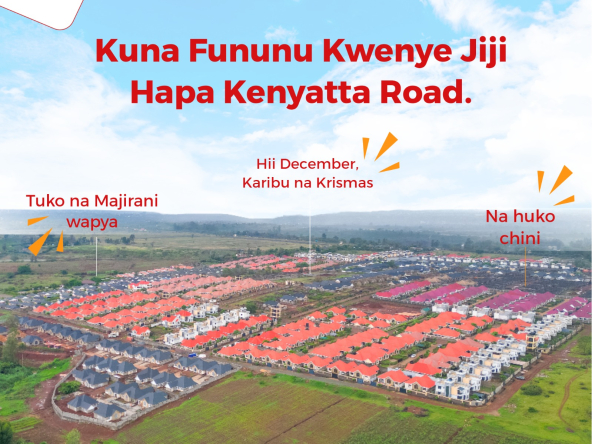As Kenya’s cities continue to grow vertically, apartment living has become the new normal for middle-class families. Yet, an often-overlooked question quietly shapes tenant choices: Which floor is better — the cool, accessible ground floor or the bright, airy top floor?
In most five-storey apartments across Nairobi, Mombasa, and Kisumu, residents have observed a simple truth — ground floors are cooler, while top floors are notably warmer. Though this may sound trivial, the thermal difference between these levels can reach up to 4°C, influencing comfort, energy bills, and even long-term health. Understanding this difference helps home seekers make smarter, climate-conscious decisions in Kenya’s modern housing market.
Why Ground Floors Stay Cool — and Top Floors Heat Up
The difference in temperature between floors is mainly caused by physics and materials. Ground floors are partially shielded by the surrounding earth, which acts as a natural thermal insulator. Heat from the sun is absorbed and dissipated slowly, keeping lower floors relatively stable in temperature.
Top floors, on the other hand, sit directly under the roof — often made of corrugated iron sheets or concrete that absorbs immense daytime heat. Without proper insulation, this heat radiates into the living space, making upper floors several degrees warmer by late afternoon.
Studies in tropical cities show that uninsulated top apartments can average 3–5°C hotter than ground floors during the day, depending on roofing materials, ventilation, and wall exposure.
Read Also: Digital Landlords: How TikTok, Instagram, and YouTube Are Driving Real Estate Sales in Kenya
Comparing Comfort Levels Across Floors

Below is a simplified illustration of how temperatures typically vary in a five-storey residential building under tropical conditions (such as Nairobi’s 24–29°C daytime average).
Pros, Cons and Who Should Live Where (5-storey apartment )
| Floor | Typical Avg Temp (example) | Pros | Cons | Recommended for |
|---|---|---|---|---|
| Ground (1) | 24.5°C | Coolest, easiest access, lowest cooling costs | Can be damp, colder, higher pest risk, more street noise, less privacy | Elderly with mobility issues (if building is dry & secure); adults who prioritize access over humidity concerns — not ideal for infants/toddlers |
| 2nd (2) | 25.3°C | Balanced temperature, easier access than high floors, drier than ground | Moderate noise, moderate privacy | Families with toddlers and young children; older adults who prefer few stairs |
| 3rd (3) | 26.1°C | Good privacy, moderate temperature, lower damp risk | Less immediate access to ground-level exit | Small families, parents with young kids who want quieter but not too warm units |
| 4th (4) | 26.9°C | Better view and daylight, less street noise | Warmer; depends on elevator reliability | Professionals, smaller households without very young children |
| Top (5) | 28.5°C | Best views, most privacy, quietest | Warmest, may require cooling; elevator dependence | Young professionals, those who prioritize view/privacy and can manage cooling |
(Data based on tropical climate heat gradient in mid-rise buildings.)
A line chart depicting this pattern shows a steady climb from 24.5°C on the ground floor to 28.5°C on the top, confirming that higher floors absorb and retain more heat throughout the day.
Who Should Choose the Ground Floor

Ground floors are ideal for elderly residents, and people with disabilities due to their easy accessibility and naturally cooler temperatures. In Kenya’s hotter regions like Mombasa or Machakos, lower floors offer significant relief from afternoon heat and reduce reliance on air conditioning or fans.
However, they’re not perfect. Noise from streets or shared courtyards can be bothersome, and poor drainage or dampness may cause discomfort in older buildings. Enhanced security and moisture control measures — such as grills, motion lights, and proper landscaping — can make ground living both safe and serene.
Read Also: How Diaspora Buyers Are Quietly Changing Kenya’s Real Estate Financing Models
Who Benefits from Top Floor Living
Top floors, though warmer, attract residents seeking views, privacy, and quiet. In bustling Nairobi estates such as Kilimani or Kileleshwa, top units often command a small premium for their panoramic outlook and reduced street disturbance.
These apartments are best suited for young professionals, remote workers, or small households that can manage slightly warmer interiors or afford additional cooling solutions. Installing roof insulation, reflective coatings, or ceiling fans can drastically cut heat gain and improve comfort.
Energy Implications
Temperature differences between floors influence power consumption. A study of tropical apartments found that top-floor units may consume up to 25% more cooling energy than ground floors when using fans or air conditioners. Meanwhile, ground floors may require minimal cooling, but they sometimes experience higher humidity, which can affect air quality if ventilation is poor.
For developers, the lesson is clear: roof insulation, proper ventilation shafts, and reflective paints are cost-effective ways to make all floors energy-efficient.
The Balanced Middle Floors
Interestingly, second and third floors often provide the best of both worlds — moderate temperatures, sufficient light, and less noise. In Nairobi’s mid-rise apartment blocks, these floors are increasingly popular among tenants who value comfort without extremes of heat or accessibility challenges.
Practical Tips for Residents
- Ground floor: Use moisture-proof paints, seal windows properly, and install motion lighting for safety.
- Middle floors: Maximize ventilation by opening opposite windows in the morning and evening.
- Top floor: Insulate your ceiling, add reflective roof paint, and consider solar ventilation fans.
- All floors: Use curtains and indoor plants to regulate temperature and improve air quality.
Choosing Comfort, Not Just Height
In Kenya’s evolving urban landscape, floor choice is more than a matter of preference — it’s a decision that affects comfort, safety, and cost of living. While the ground floor offers cool convenience, and the top floor offers warmth and views, the right choice depends on who you are and how you live.




